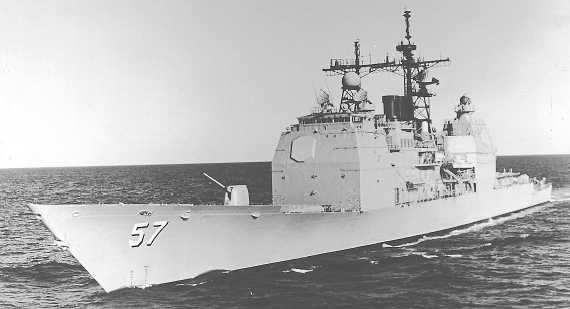| |
The United States traditionally named battle-
ships after states. Since our nation is unlikely to
build any more battleships, it now gives state names
to cruisers, such as the California (CGN-36), and
submarines (SSBNs), such as the Ohio and the
Michigan.
CRUISERS.
—Cruisers
are
medium-sized,
general-utility ships. They have a large cruising
range and are capable of high speeds (over 30 knots).
They serve as protective screens against surface and
air attacks and also provide gunfire support for land
operations. Because of modern high-performance
aircraft and guided missiles, the cruisers in service
today are designed to carry guided missiles. The two
basic types of cruisers are the guided-missile cruiser
(CG) and guided-missile cruiser (nuclear propulsion)
(CGN). Cruisers displace about 10,000 to 21,500 tons.
The CG carries guns as well as missiles. The CG-47
class (fig. 19-3) is the first to employ vertical launch
missile tubes and the shipboard integrated AAW
combat weapons system (Aegis). CGNs are the same
as the CGs except that their main engines are
nuclear powered.
At one time cruisers were named after cities; but
after the completion of the Long Beach (CGN-9), the
names of cities were assigned to newly constructed
auxiliary ships (AOEs/AORs/ AFSs). The names of
cities are also given to attack submarines, beginning
with the Los Angeles (SSN-688) class. Several active
cruisers, formerly classified as guided-missile frigates
and named after Navy and Marine Corps personnel
and Secretaries of the Navy, have retained their
destroyer-type names. Other cruisers, beginning with
the CGN-36, are named after states. The CG-47-class
cruisers are named after revolutionary war battles.
DESTROYERS. —Destroyers (DDs) and guided-
missiles destroyers (DDGs) are multi-purpose ships
that are useful in almost any kind of naval operation.
They are fast ships with a variety of armament, but
little or no armor. For protection, they depend on
their speed and mobility. Their displacement varies
from about 4,500 tons to 7,800 tons.
The principal mission of destroyers is to operate
offensively and defensively against submarines and
surface ships and to take defensive action against air
attacks. They also provide gunfire support for
amphibious assaults and perform patrol, search, and
rescue missions.
The destroyer’s armament consists of 5-inch guns
and a variety of antisubmarine weapons, such as
torpedoes, antisubmarine rockets (ASROCs), and
Terrier and Tartar missiles.
Traditionally, destroyers have been named after
officers and enlisted personnel of the Navy and
Marine Corps and Secretaries of the Navy. Because
destroyers make up the Navy’s largest group of si-
milar types of ships, we will mention only a few to
give you some idea of the several types and classes.
The Navy’s destroyer of the future is the Arleigh
Burke class (DDG-51) (fig. 19-4). The all-steel
construction of the DDG-51 is designed
134.109
Figure 19-3.-USS Lake Champlain (CG-57) under way during sea trials.
19-6
|

